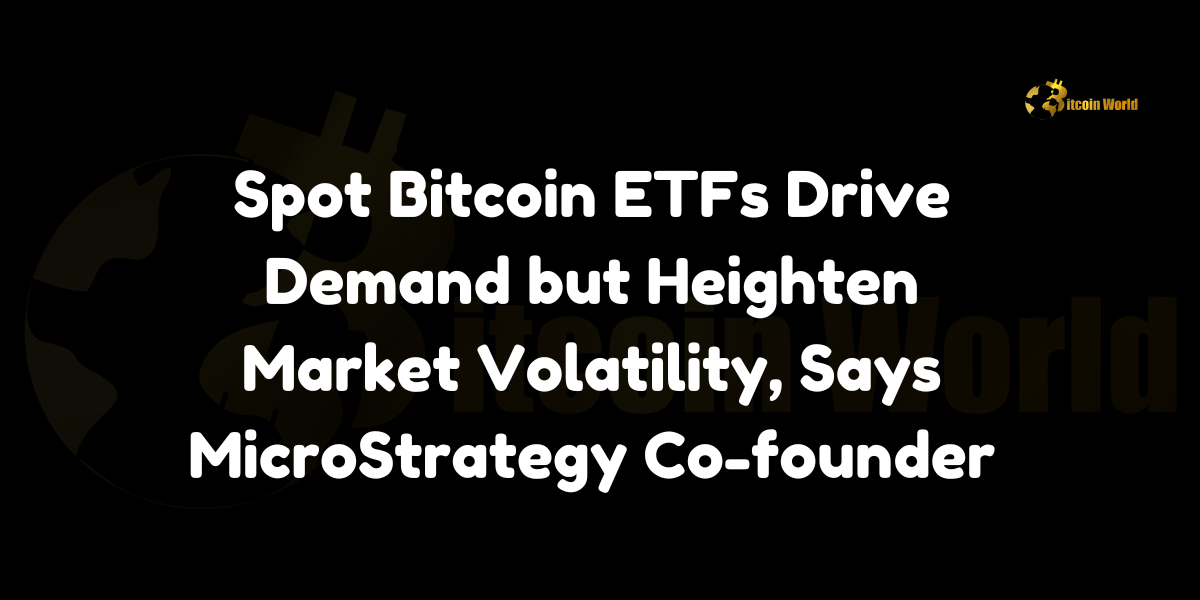Spot Bitcoin ETFs are reshaping the cryptocurrency landscape, driving increased demand but also heightening market volatility. MicroStrategy’s co-founder, Michael Saylor, emphasized these contrasting effects in a recent interview, pointing to Bitcoin’s growing role in the financial sector. While spot Bitcoin ETFs offer investors a simplified way to gain exposure to Bitcoin, they come with potential risks, particularly related to market fluctuations. In this article, we’ll explore Saylor’s insights on how spot Bitcoin ETFs are impacting the market and MicroStrategy’s unique approach to leveraging Bitcoin for financial growth.
Bitcoin’s Role in MicroStrategy’s Growth Strategy
MicroStrategy has long been at the forefront of integrating Bitcoin into its business strategy. According to Michael Saylor, the company has accumulated $8.3 billion worth of Bitcoin to date, an investment that has delivered an impressive 44% annual return. For comparison, this performance significantly outpaces the S&P 500, which has offered an average annual return of just 12% in recent years.
Saylor’s strategy of heavily investing in Bitcoin while maintaining the company’s core software business has been a bold move. MicroStrategy has become a pioneer among institutional investors, leading the way in showcasing the cryptocurrency’s potential as a major asset class.
Securitizing Bitcoin Through Convertible Bonds
One of the key aspects of MicroStrategy’s unique approach to Bitcoin investment is its use of convertible bonds backed by Bitcoin. This innovative strategy allows the company to offer higher yields to investors compared to spot Bitcoin ETFs. These bonds are an attractive option for investors seeking exposure to Bitcoin while also wanting to mitigate some of the risks associated with direct ownership or ETF investments.
The company’s convertible bonds provide a diversified investment opportunity, giving investors both the potential upside of Bitcoin appreciation and the relative safety of a bond structure. This securitization of Bitcoin is a clear example of how institutional players like MicroStrategy are seeking to blend traditional finance with the new opportunities presented by cryptocurrencies.
Spot Bitcoin ETFs: Benefits and Risks
While the rise of spot Bitcoin ETFs has democratized access to the cryptocurrency market, allowing more investors to enter the space, Michael Saylor notes that these financial products also introduce new risks. Spot Bitcoin ETFs are designed to track the real-time price of Bitcoin, offering a simpler way for retail and institutional investors to gain exposure to the cryptocurrency without directly purchasing it.
However, Saylor points out that the liquidity and fast-paced trading of these ETFs can contribute to increased volatility in the Bitcoin market. As Bitcoin is a highly liquid asset, spot ETFs allow for swift buying and selling, which can lead to rapid price movements that may unsettle less-experienced investors. This heightened volatility is one of the key concerns surrounding the proliferation of spot Bitcoin ETFs.
Moreover, Saylor acknowledges that while spot ETFs boost demand for Bitcoin, the resulting price swings may discourage long-term investors who are looking for stability. Despite this, he reaffirms Bitcoin’s value as a long-term store of wealth, suggesting that the cryptocurrency’s potential far outweighs the short-term volatility associated with these financial products.
Bitcoin as a Long-Term Store of Wealth
Despite the volatility associated with spot Bitcoin ETFs, Michael Saylor remains bullish on Bitcoin’s role as a long-term store of value. He believes that Bitcoin’s finite supply, combined with growing institutional interest, will ensure its appreciation over time. In his view, short-term fluctuations in price are part of the natural maturation process of the asset class.
Saylor compares Bitcoin to digital gold, emphasizing its unique properties as a hedge against inflation and economic instability. As central banks around the world continue to print money and increase debt levels, Bitcoin’s fixed supply makes it an attractive alternative for investors seeking to protect their wealth. This long-term perspective aligns with MicroStrategy’s broader investment strategy, which prioritizes Bitcoin as a key asset for future growth.
The Future of Bitcoin ETFs and Market Impact
The introduction of spot Bitcoin ETFs has undoubtedly changed the dynamics of the cryptocurrency market. As more investment firms and exchanges roll out Bitcoin ETF offerings, both retail and institutional investors have easier access to Bitcoin. However, the question remains whether the increased volatility these ETFs bring will overshadow their benefits in the long run.
Michael Saylor’s views provide valuable insight into the potential future of Bitcoin ETFs and their impact on the market. While he acknowledges the risks, he remains optimistic about Bitcoin’s long-term value proposition. As the market matures, the growing acceptance of Bitcoin as a legitimate asset class is likely to bring more stability over time, even as spot Bitcoin ETFs contribute to short-term price swings.
Conclusion: Spot Bitcoin ETFs are revolutionizing the way investors interact with Bitcoin, driving demand and offering greater accessibility to the asset. However, as Michael Saylor has highlighted, these financial products also bring about increased volatility, which could deter certain
To learn more about the innovative startups shaping the future of the crypto industry, explore our article on latest news, where we delve into the most promising ventures and their potential to disrupt traditional industries.
Disclaimer: The information provided is not trading advice, Bitcoinworld.co.in holds no liability for any investments made based on the information provided on this page. We strongly recommend independent research and/or consultation with a qualified professional before making any investment decisions.



